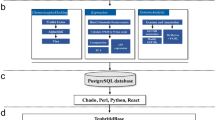Abstract
Eriophyid mites are commonly found on the leaf surface of different plant species. In the present study, a novel virus associated with an eriophyid mite species was detected using high-throughput sequencing (HTS) of total RNA from fruit tree leaves, primarily growing under greenhouse conditions. The complete genome sequence was characterized using rapid amplification of cDNA ends followed by Sanger sequencing, revealing a genome of 8885 nucleotides in length. The single positive-stranded RNA genome was predicted to encode typical conserved domains of members of the genus Iflavirus in the family Iflaviridae. Phylogenetic analysis showed this virus to be closely related to the unclassified iflavirus tomato matilda associated virus (TMaV), with a maximum amino acid sequence identity of 59% in the RNA-dependent RNA polymerase domain. This low identity value justifies the recognition of the novel virus as a potential novel iflavirus. In addition to a lack of graft-transmissibility evidence, RT-PCR and HTS detection of this virus in the putative host plants were not consistent through different years and growing seasons, raising the possibility that rather than a plant virus, this was a virus infecting an organism associated with fruit tree leaves. Identification of Tetra pinnatifidae HTS-derived contigs in all fruit tree samples carrying the novel virus suggested this mite as the most likely host of the new virus (p-value < 1e-11), which is tentatively named “eriophyid mite-associated virus” (EMaV). This study highlights the importance of a careful biological study before assigning a new virus to a particular plant host when using metagenomics data.


Similar content being viewed by others
Availability of data and materials
The complete genome sequence of the new virus characterized in the present study is openly available in the GenBank database with the reference number MW824924.
References
Oers MMV (2010) Genomics and biology of lflaviruses. Insect Virol 231–250
Valles SM, Chen Y, Firth AE et al (2017) ICTV virus taxonomy profile: Iflaviridae. J Gen Virol 98:527–528. https://doi.org/10.1099/jgv.0.000757
Ye ZX, Li YH, Chen JP et al (2021) Complete genome analysis of a novel iflavirus from a leaf beetle, Aulacophora lewisii. Arch Virol 166:309–312. https://doi.org/10.1007/s00705-020-04859-1
Saqib M, Wylie SJ, Jones MGK (2015) Serendipitous identification of a new Iflavirus-like virus infecting tomato and its subsequent characterization. Plant Pathol 64:519–527. https://doi.org/10.1111/ppa.12293
Bolger AM, Lohse M, Usadel B (2014) Trimmomatic: a flexible trimmer for Illumina sequence data. Bioinformatics 30:2114–2120. https://doi.org/10.1093/bioinformatics/btu170
Bankevich A, Nurk S, Dmitry A et al (2012) SPAdes: a new genome assembly algorithm and its applications to single-cell sequencing. J Comput Biol 19:455–477
Larkin MA, Blackshields G, Brown NP et al (2007) Clustal W and Clustal X version 2.0. Bioinformatics 23:2947–2948. https://doi.org/10.1093/bioinformatics/btm404
Le SQ, Gascuel O (2008) An improved general amino acid replacement matrix. Mol Biol Evol 25:1307–1320. https://doi.org/10.1093/molbev/msn067
Kumar S, Stecher G, Tamura K (2016) MEGA7: molecular evolutionary genetics analysis version 7.0 for bigger datasets. Mol Biol Evol 33:1870–1874. https://doi.org/10.1093/molbev/msw054
Xue X, Song Z, Hong X (2006) A taxonomic study of the genus Tetra Keifer (Acari: Eriophyidae: Phyllocoptinae: Anthocoptini) from Shaanxi Province, China with descriptions of nine new species. Zootaxa 22:1–22
de Lillo E, Pozzebon A, Valenzano D, Duso C (2018) An intimate relationship between eriophyoid mites and their host plants—a review. Front Plant Sci 9:1–14. https://doi.org/10.3389/fpls.2018.01786
R Core Team (2013) R: A language and enviroment for statistical computing. R Foundation for Statistical Computing. Vienna. http://www.r-project.org/
Villamor DEV, Ho T, Al Rwahnih M et al (2019) High throughput sequencing for plant virus detection and discovery. Phytopathology 109:716–725. https://doi.org/10.1094/PHYTO-07-18-0257-RVW
Funding
This research was supported by USDA APHIS project 20-8224-2121 IA.
Author information
Authors and Affiliations
Corresponding author
Ethics declarations
Conflict of interest
The authors declare that they have no conflict of interest.
Ethical approval
This article does not contain any studies with human participants performed by any of the authors.
Additional information
Handling Editor: Simona Abba'.
Publisher's Note
Springer Nature remains neutral with regard to jurisdictional claims in published maps and institutional affiliations.
Supplementary Information
Below is the link to the electronic supplementary material.
705_2021_5174_MOESM2_ESM.pdf
Supplementary file2 ESM 2 Contingency table for the number of samples testing positive and negative for both the novel virus and the mite Tetra pinnatifidae (PDF 32 KB)
Rights and permissions
About this article
Cite this article
Carvalho Costa, L., Stevens, K., Hu, X. et al. Identification and characterization of a novel virus associated with an eriophyid mite in extracts of fruit trees leaves. Arch Virol 166, 2869–2873 (2021). https://doi.org/10.1007/s00705-021-05174-z
Received:
Accepted:
Published:
Issue Date:
DOI: https://doi.org/10.1007/s00705-021-05174-z




